Chapter 2D. Guide Signs—Conventional Roads
Section 2D.26 Directional Arrow Auxiliary Signs (M6 Series)
Standard:
If used, the Directional Arrow auxiliary sign (see Figure
2D-5) shall be mounted below the route sign in directional assemblies,
and displays a single- or double-headed arrow pointing in the general
direction that the route follows.
Section 2D.27 Route Sign Assemblies
Standard:
A Route Sign assembly shall consist of a route sign and auxiliary
signs that further identify the route and indicate the direction.
Route Sign assemblies shall be installed on all approaches to numbered
routes that intersect with other numbered routes.
Where two or more routes follow the same section of highway, the route signs for Interstate, U.S., State, and County routes shall be mounted in that order from the left in horizontal arrangements and from the top in vertical arrangements. Subject to this order of precedence, route signs for lower-numbered routes shall be placed at the left or top.
Within groups of assemblies, information for routes intersecting from the left shall be mounted at the left in horizontal arrangements and at the top or center of vertical arrangements. Similarly, information for routes intersecting from the right shall be at the right or bottom, and for straight-through routes at the center in horizontal arrangements or top in vertical arrangements.
Route Sign assemblies shall be mounted in accordance with the general specifications for highway signs (Chapter 2A), with the lowest sign in the assembly at the height prescribed for single signs.
Guidance:
Assemblies for two or more routes, or for different directions on
the same route, should be mounted in groups on a common support.
Option:
Route Sign assemblies may be installed on the approaches to numbered
routes on unnumbered roads and streets that carry an appreciable
amount of traffic destined for the numbered route.
If engineering judgment indicates that groups of assemblies that include overlapping routes or multiple turns might be confusing, route signs or auxiliary signs may be omitted or combined, provided that clear directions are given to road users.
Support:
Figure 2D-6 shows typical placements of route signs.
Figure 2D-6 Illustration of Directional Assemblies and Other Route Signs (For One Direction of Travel Only) (3 Sheets)
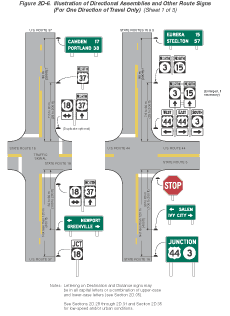
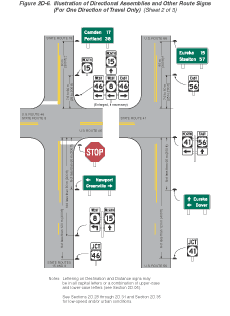
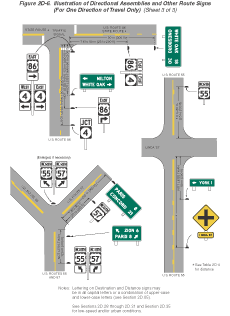
Section 2D.28 Junction Assembly
Standard:
A Junction assembly shall consist of a Junction auxiliary sign and
a route sign. The route sign shall carry the number of the intersected
or joined route.
The Junction assembly shall be installed in advance of every intersection where a numbered route is intersected or joined by another numbered route. In urban areas it shall be installed in the block preceding the intersection, and in rural areas it shall be installed at least 120 m (400 ft) in advance of the intersection. In rural areas, the minimum distance between the Destination sign and the Route Turn assembly shall be 60 m (200 ft), and the minimum distance between the Route Turn assembly and the Junction assembly shall be 60 m (200 ft).
Guidance:
In urban areas where speeds are low, the Junction assembly should
not be installed more than 90 m (300 ft) in advance of the intersection.
Where prevailing speeds are high, greater spacings should be used.
Option:
Where two or more routes are to be indicated, a single Junction
auxiliary sign may be used for the assembly and all route signs
grouped in a single mounting, or a Combination Junction sign (see
Section 2D.14) may be used.
Section 2D.29 Advance Route Turn Assembly
Standard:
An Advance Route Turn assembly shall consist of a route sign, an
Advance Turn Arrow or word message auxiliary sign, and a Cardinal
Direction auxiliary sign, if needed. It shall be installed in advance
of an intersection where a turn must be made to remain on the indicated
route.
Option:
The Advance Route Turn assembly may be used to supplement the required
Junction assembly in advance of intersecting routes.
Guidance:
Where a multiple-lane highway approaches an interchange or intersection
with a numbered route, the Advance Route Turn assembly should be
used to pre-position turning vehicles in the correct lanes from
which to make their turn.
In low-speed areas, the Advance Route Turn assembly should be installed not less than 60 m (200 ft) in advance of the turn. In high-speed areas, the Advance Route Turn assembly should be installed not less than 90 m (300 ft) in advance of the turn.
Standard:
An assembly that includes an Advance Turn Arrow auxiliary sign shall
not be placed where there is an intersection between it and the
designated turn.
Guidance:
Sufficient distance should be allowed between the assembly and any
preceding intersection that could be mistaken for the indicated
turn.
Section 2D.30 Directional Assembly
Standard:
A Directional assembly shall consist of a route sign, a Directional
Arrow auxiliary sign, and a Cardinal Direction auxiliary sign, if
needed. The various uses of Directional assemblies shall be as outlined
below:
- Turn movements (indicated in advance by an Advance Route Turn assembly) shall be marked by a Directional assembly with a route sign displaying the number of the turning route and a single-headed arrow pointing in the direction of the turn.
- The beginning of a route (indicated in advance by a Junction assembly) shall be marked by a Directional assembly with a route sign displaying the number of that route and a single-headed arrow pointing in the direction of the route.
- The end of a route shall be marked by a Directional assembly with an END auxiliary sign and a route sign displaying the number of that route.
- An intersected route (indicated in advance by a Junction assembly)
shall be designated by:
- Two Directional assemblies, each with a route sign displaying the number of the intersected route, a Cardinal Direction auxiliary sign, and a singleheaded arrow pointing in the direction of movement on that route; or
- A Directional assembly with a route sign displaying the number of the intersected route and a double-headed arrow, pointing at appropriate angles to the left, right, or ahead.
Guidance:
Straight-through movements should be indicated by a Directional
assembly with a route sign displaying the number of the continuing
route and a vertical arrow. A Directional assembly should not be
used for a straight-through movement in the absence of other assemblies
indicating right or left turns, as the Confirming assembly sign
beyond the intersection normally provides adequate guidance.
Directional assemblies should be located on the near right corner of the intersection. At major intersections and at Y or offset intersections, additional Directional assemblies should be installed on the far right or left corner to confirm the near-side assemblies. When the near-corner position is not practical for Directional assemblies, the far right corner should be the preferred alternative, with oversized signs, if necessary, for legibility. Where unusual conditions exist, the location of a Directional assembly should be determined by engineering judgment with the goal being to provide the best possible combination of view and safety.
Support:
It is more important that guide signs be readable at the right time
and place than to be located with absolute uniformity.
Figure 2D-6 shows typical placements of Directional assemblies.
Section 2D.31 Confirming or Reassurance Assemblies
Standard:
If used, Confirming or Reassurance assemblies shall consist of a
Cardinal Direction auxiliary sign and a route sign.
Guidance:
A Confirming assembly should be installed just beyond intersections
of numbered routes. It should be placed 7.6 to 60 m (25 to 200 ft)
beyond the far shoulder or curb line of the intersected highway.
If used, Reassurance assemblies should be installed between intersections in urban districts as needed, and beyond the built-up area of any incorporated City or town.
Route signs for either confirming or reassurance purposes should be spaced at such intervals as necessary to keep road users informed of their routes.
Support:
Confirming and Reassurance assemblies are considered to be a type
of Directional assembly.
Section 2D.32 Trailblazer Assembly
Support:
Trailblazer assemblies provide directional guidance to a particular
road facility from other highways in the vicinity. This is accomplished
by installing Trailblazer assemblies at strategic locations to indicate
the direction to the nearest or most convenient point of access.
The use of the word TO indicates that the road or street where the
sign is posted is not a part of the indicated route, and that a
road user is merely being directed progressively to the route.
Standard:
A Trailblazer assembly shall consist of a TO auxiliary sign, a route
sign (or a special road facility symbol), and a single-headed Directional
Arrow auxiliary sign pointing in the direction leading to the route.
Option:
A Cardinal Direction auxiliary sign may be used with a Trailblazer
assembly.
Guidance:
The TO auxiliary sign, Cardinal Direction auxiliary sign, and Directional
Arrow auxiliary sign should be of the standard size specified for
auxiliary signs of their respective type. The route sign should
be the size specified in Section
2D.11.
Option: Trailblazer assemblies may be installed with other Route Sign assemblies, or alone, in the immediate vicinity of the designated facilities.
Section 2D.33 Destination and Distance Signs
Support:
In addition to guidance by route numbers, it is desirable to supply
the road user information concerning the destinations that can be
reached by way of numbered or unnumbered routes. This is done by
means of Destination signs and Distance signs.
Option:
Route and Cardinal Direction auxiliary signs may be included on
the Destination sign panel with the destinations and arrows.
Guidance:
The size of the route signs and Cardinal Direction auxiliary signs
should be at least the minimum size specified for these signs.
Section 2D.34 Destination Signs (D1 Series)
Standard:
Except where special interchange signing is prescribed, the Destination
(D1-1 through D1-3) sign (see Figure 2D-7), if used, shall be a
horizontal rectangle carrying the name of a City, town, village,
or other traffic generator, and a directional arrow.
Figure 2D-7 Destination and Distance Signs
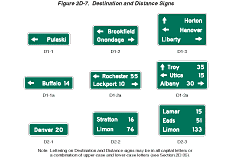
Option:
The distance (see Section 2D.36) to the
place named may also be shown on the Destination (D1-1a through
D1-3a) sign (see Figure 2D-7). If several destinations are to be
shown at a single point, the several names may be placed on a single
panel with an arrow (and the distance, if desired) for each name.
If more than one destination lies in the same direction, a single
arrow may be used for such a group of destinations.
Guidance:
Adequate separation should be made between any destinations or group
of destinations in one direction and those in other directions by
suitable design of the arrow, spacing of lines of legend, heavy
lines entirely across the panel, or separate panels.
Standard:
An arrow pointing to the right shall be at the extreme right of
the sign, and an arrow pointing left or up shall be at the extreme
left. The distance figures, if used, shall be placed to the right
of the destination names.
Guidance:
Unless a sloping arrow will convey a clearer indication of the direction
to be followed, the directional arrows should be horizontal or vertical.
Guidance:
If several individual name panels are assembled into a group, all
panels in the assembly should be of the same length.
Destination signs should be used:
- At the intersections of U.S. or State numbered routes with Interstate, U.S., or State numbered routes; and
- At points where they serve to direct traffic from U.S. or State numbered routes to the business section of towns, or to other destinations reached by unnumbered routes.
Standard:
Where a total of three or less destinations are provided on the
Advance Guide (see Section 2E.30)
and Supplemental Guide (see Section
2E.32) signs, not more than three destination names shall be
used on a Destination sign. Where four destinations are provided
by the Advance Guide and Supplemental Guide signs, not more than
four destination names shall be used on a Destination sign.
Guidance:
If space permits, four destinations should be displayed as two separate
sign panels.
Option:
Where space does not permit, or where all four destinations are
in one direction, a single sign assembly may be used.
Standard:
Where a single four-name sign assembly is used, a heavy line entirely
across the panel or separated sign panels shall be used to separate
destinations by direction.
Guidance:
The next closest destination lying straight ahead should be at the
top of the sign or assembly, and below it the closest destinations
to the left and to the right, in that order. The destination shown
for each direction should ordinarily be the next County seat or
the next principal City, rather than a more distant destination.
In the case of overlapping routes, there should be shown only one
destination in each direction for each route.
Standard:
If there is more than one destination shown in the same direction,
the name of the nearest destination shall appear above the names
of any destinations that are further away.
Section 2D.35 Location of Destination Signs
Guidance:
When used in high-speed areas, Destination signs should be located
60 m (200 ft) or more in advance of the intersection, and following
any Junction or Advance Route Turn assemblies that may be required.
Option:
In urban areas, shorter advance distances may be used.
Because the Destination sign is of lesser importance than the Junction, Advance Route Turn, or Directional assemblies, the Destination sign may be eliminated when sign spacing is critical.
Support:
Figure 2D-6 shows typical placements of
Destination signs.
Section 2D.36 Distance Signs (D2 Series)
Standard:
If used, the Distance (D2-1 through D2-3) sign (see Figure 2D-7)
shall be a horizontal rectangle of a size appropriate for the required
legend, carrying the names of not more than three Cities, towns,
junctions, or other traffic generators, and the distance (to the
nearest kilometer or mile) to those places.
Guidance:
The distance shown should be selected on a case-by-case basis by
the jurisdiction that owns the road or by statewide policy. A well-defined
central area or central business district should be used where one
exists. In other cases, the layout of the community should be considered
in relation to the highway being signed and the decision based on
where it appears that most drivers would feel that they are in the
center of the community in question.
The top name on the Distance sign should be that of the next place on the route having a post office or a railroad station, a route number or name of an intersected highway, or any other significant geographical identity. The bottom name on the sign should be that of the next major destination or control city. If three destinations are shown, the middle line should be used to indicate communities of general interest along the route or important route junctions.
Option:
The choice of names for the middle line may be varied on successive
Distance signs to give road users additional information concerning
communities served by the route.
Guidance:
The control city should remain the same on all successive Distance
signs throughout the length of the route until that City is reached.
Option:
If more than one distant point may properly be designated, such
as where the route divides at some distance ahead to serve two destinations
of similar importance, and if these two destinations cannot appear
on the same sign, the two names may be alternated on successive
signs.
On a route continuing into another State, destinations in the adjacent State may be shown.
Section 2D.37 Location of Distance Signs
Guidance:
If used, Distance signs should be installed on important routes
leaving municipalities and just beyond intersections of numbered
routes in rural areas. If used, they should be placed just outside
the municipal limits or at the edge of the built-up district if
it extends beyond the limits.
Where overlapping routes separate a short distance from the municipal limits, the Distance sign at the municipal limits should be omitted. The Distance sign should be installed approximately 90 m (300 ft) beyond the separation of the two routes.
Where, just outside of an incorporated municipality, two routes are concurrent and continue concurrently to the next incorporated municipality, the top name on the Distance sign should be that of the place where the routes separate; the bottom name should be that of the City to which the greater part of the through traffic is destined.
Support:
Figure 2D-6 shows typical placements of
Distance signs.
Section 2D.38 Street Name Sign (D3-1)
Guidance:
Street Name (D3-1) signs (see Figure 2D-8) should be installed in
urban areas at all street intersections regardless of other route
signs that may be present and should be installed in rural areas
to identify important roads that are not otherwise signed.
Figure 2D-8 Street Name and Parking Signs
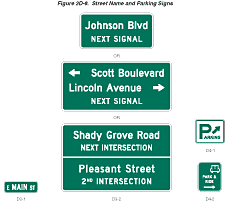
Lettering on ground-mounted Street Name signs should be at least 150 mm (6 in) high in capital letters, or 150 mm (6 in) upper-case letters with 113 mm (4.5 in) lower-case letters.
On multi-lane streets with speed limits greater than 60 km/h (40 mph), the lettering on ground-mounted Street Name signs should be at least 200 mm (8 in) high in capital letters, or 200 mm (8 in) upper-case letters with 150 mm (6 in) lower-case letters.
Option:
For local roads with speed limits of 40 km/h (25 mph) or less, the
lettering height may be a minimum of 100 mm (4 in).
Supplementary lettering to indicate the type of street (such as Street, Avenue, or Road) or the section of the City (such as NW) may be in smaller lettering, at least 75 mm (3 in) high. Conventional abbreviations (see Section 1A.14) may be used except for the street name itself.
A symbol or letter designation may be used on a Street Name sign to identify the governmental jurisdiction, area of jurisdiction, or other government-approved institution.
Standard:
If a symbol or letter designation is used, the height and width
of the symbol or letter designation shall not exceed the letter
height of the sign.
Guidance:
The symbol or letter designation should be positioned to the left
of the street name.
Standard:
The Street Name sign shall be retroreflective or illuminated to
show the same shape and similar color both day and night. The legend
and background shall be of contrasting colors.
Guidance:
Street Name signs should have a white legend on a green background.
A border, if used, should be the same color as the legend.
In business districts and on principal arterials, Street Name signs should be placed at least on diagonally opposite corners. In residential areas, at least one Street Name sign should be mounted at each intersection. Signs naming both streets should be installed at each intersection. They should be mounted with their faces parallel to the streets they name.
Option:
To optimize visibility, Street Name signs may be mounted overhead.
Street Name signs may also be placed above a regulatory or STOP
or YIELD sign with no required vertical separation.
At intersection crossroads where the same road has two different street names for each direction of travel, both street names may be shown on the same sign along with directional arrows.
Guidance:
In urban or suburban areas, especially where Advance Street Name
signs are not used, the use of overhead-mounted Street Name signs
should be considered. If overhead Street Name signs are used, the
lettering should be at least 300 mm (12 in) high in capital letters,
or 300 mm (12 in) upper-case letters with 225 mm (9 in) lower-case
letters.
Support:
Information regarding the use of street names on supplemental plaques
for use with intersection-related warning signs is contained in
Section 2C.49.
Section 2D.39 Advance Street Name Signs (D3-2)
Support:
Advance Street Name (D3-2) signs (see Figure
2D-8) identify an upcoming intersection. Although this is often
the next intersection, it could also be several intersections away
in cases where the next signalized intersection is referenced.
Standard:
Advance Street Name (D3-2) signs, if used, shall supplement rather
than be used instead of the Street Name (D3-1) signs at the intersection.
Option:
Advance Street Name (D3-2) signs may be installed in advance of
signalized or unsignalized intersections to provide road users with
advance information to identify the name(s) of the next intersecting
street to prepare for crossing traffic and to facilitate timely
deceleration and/or lane changing in preparation for a turn.
Guidance:
On arterial highways in rural areas, Advance Street Name signs should
be used in advance of all signalized intersections and in advance
of all intersections with exclusive turn lanes.
In urban areas, Advance Street Name signs should be used in advance of all signalized intersections on major arterial streets, except where signalized intersections are so closely spaced that advance placement of the signs is impractical.
The heights of the letters on Advance Street Name signs should be the same as those used for Street Name signs (see Section 2D.38).
Standard:
If used, Advance Street Name signs shall have a white legend and
border on a green background.
If used, Advance Street Name signs shall provide the name(s) of the intersecting street(s) on the top line(s) of the legend and the distance to the intersecting streets or messages such as NEXT SIGNAL, NEXT INTERSECTION, or directional arrow(s) on the bottom line of the legend.
Option:
Directional arrow(s) may be placed to the right or left of the street
name or message such as NEXT SIGNAL, as appropriate, rather than
on the bottom line of the legend.
For intersecting crossroads where the same road has a different street name for each direction of travel, the different street names may be shown on the same Advance Street Name sign along with directional arrows.
In advance of two closely spaced intersections where it is not practical to install separate Advance Street Name signs, the Advance Street Name sign may include the street names for both intersections along with appropriate supplemental legends for both street names, such as NEXT INTERSECTION, 2ND INTERSECTION, or NEXT LEFT and NEXT RIGHT, or advance directional arrows.
An Advance Street Name (W16-8) plaque with black legend on a yellow background, installed supplemental to an Intersection (W2) or Advance Traffic Control (W3) series warning sign may be used instead of an Advance Street Name guide sign (see Section 2C.49).
Section 2D.40 Parking Area Sign (D4-1)
Option:
The Parking Area (D4-1) sign (see Figure 2D-8) may be used to show
the direction to a nearby public parking area.
Standard:
If used, the sign shall be a horizontal rectangle with a standard
size of 750 x 600 mm (30 x 24 in), or with a smaller size of 450
x 375 mm (18 x 15 in) for minor, low-speed streets. It shall carry
the word PARKING, with the letter P five times the height of the
remaining letters, and a directional arrow. The legend and border
shall be green on a retroreflectorized white background.
Guidance:
If used, the Parking Area sign should be installed on major thoroughfares
at the nearest point of access to the parking facility and where
it can advise drivers of a place to park. The sign should not be
used more than four blocks from the parking area.
Section 2D.41 PARK & RIDE Sign (D4-2)
Option:
PARK & RIDE (D4-2) signs (see Figure 2D-8) may be used to direct
road users to park and ride facilities.
Standard:
The signs shall contain the word message PARK & RIDE and direction
information (arrow or word message).
Option:
PARK & RIDE signs may contain the local transit logo and/or carpool
symbol within the sign border.
Standard:
If used, the local transit logo and/or carpool symbol shall be located
in the top part of the sign above the message PARK & RIDE. In no
case shall the vertical dimension of the local transit logo and/or
carpool symbol exceed 450 mm (18 in).
Guidance:
If the function of the parking facility is to provide parking for
persons using public transportation, the local transit logo symbol
should be used on the guide sign. If the function of the parking
facility is to serve carpool riders, the carpool symbol should be
used on the guide sign. If the parking facility serves both functions,
both the logo and carpool symbol should be used.
Standard:
These signs shall have a retroreflective white legend and border
on a rectangular green background. The carpool symbol shall be as
shown for sign D4-2. The color of the transit logo shall be selected
by the local transit authority.
Option:
To increase the target value and contrast of the transit logo, and
to allow the local transit logo to retain its distinctive color
and shape, the logo may be included within a white border or placed
on a white background.
Section 2D.42 Rest Area Signs (D5 Series)
Standard:
Rest Area signs (see Figure 2D-9) shall be used only where parking
and restroom facilities are available. Signs for this purpose shall
have retroreflective white letters, symbols, and border on a blue
background.
Figure 2D-9 Rest Area and Scenic Overlook Signs
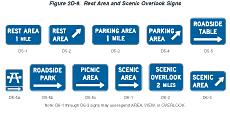
Guidance:
If used, Rest Area signs should be installed in advance of roadside
parks or rest areas to permit the driver to reduce speed and leave
the highway reasonably safely.
Option:
Messages such as REST AREA X km (X MILE) (D5-1), REST AREA (D5-2),
PARKING AREA X km (X MILE) (D5-3), PARKING AREA (D5-4), ROADSIDE
TABLE X km (X MILE), ROADSIDE PARK X km (X MILE), and PICNIC AREA
X km (X MILE) may be used, as well as other appropriate messages.
Section 2D.43 Scenic Area Signs (D6 Series)
Option:
Scenic areas may be marked by signs (see Figure 2D-9) carrying the
message SCENIC AREA, SCENIC VIEW, SCENIC OVERLOOK, or the equivalent,
together with appropriate directional information.
Guidance:
The design of the signs should be consistent with that specified
for rest areas in Section 2D.42 and should
be white letters, symbols, and border on a blue background. An advance
sign and an additional sign at the turnoff point should be used
for this kind of attraction.
Section 2D.44 Weigh Station Signing (D8 Series)
Support:
The general concept for Weigh Station signing is similar to Rest
Area signing (see Section 2D.42) because in both cases traffic using
either area remains within the right-of-way.
Standard:
The standard installation for Weigh Station signing shall include
three basic signs:
- Advance sign (D8-1);
- Exit Direction sign (D8-2); and
- Gore sign (D8-3).
Support:
Example locations of these signs are shown in Figure 2D-10.
Figure 2D-10 Example of Weigh Station Signing
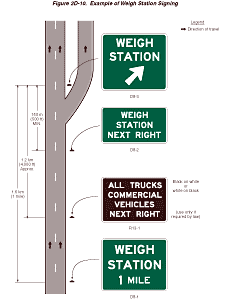
Option:
Where State law requires a regulatory sign (R13-1) in advance of
the Weigh Station, a fourth sign (see Section
2B.49) may be located following the Advance sign.
Guidance:
The Exit Direction sign (D8-2) or the Advance sign (D8-1) should
display, either within the sign border or on a supplemental panel,
the changeable message OPEN or CLOSED.
Section 2D.45 General Service Signs (D9 Series)
Support:
On conventional roads, commercial services such as gas, food, and
lodging generally are within sight and are available to the road
user at reasonably frequent intervals along the route. Consequently,
on this class of road there usually is no need for special signs
calling attention to these services. Moreover, General Service signing
is usually not required in urban areas except for hospitals, law
enforcement assistance, tourist information centers, and camping.
Option:
General Service signs (see Figure 2D-11) may be used where such
services are infrequent and are found only on an intersecting highway
or crossroad.
Figure 2D-11 General Service Signs
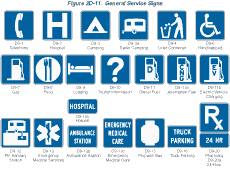
Standard:
All General Service signs and supplemental panels shall have white
letters, symbols, and borders on a blue background.
Guidance:
General Service signs should be installed at a suitable distance
in advance of the turn-off point or intersecting highway.
States that elect to provide General Service signing should establish a statewide policy or warrant for its use, and criteria for the availability of services. Local jurisdictions electing to use such signing should follow State policy for the sake of uniformity.
Option:
Individual States may sign for whatever alternative fuels are available
at appropriate locations.
Standard:
General Service signs, if used at intersections, shall be accompanied by a directional message.
Option:
The General Service legends may be either symbols or word messages.
Standard:
Symbols and word message General Service legends shall not be intermixed on the same sign. The Pharmacy (D9-20) sign shall only be used to indicate the availability of a pharmacy that is open, with a State-licensed pharmacist present and on duty, 24 hours per day, 7 days per week, and that is located within 4.8 km (3 mi) of an interchange on the Federal-aid system. The D9-20 sign shall have a 24 HR (D9-20a) plaque mounted below it.
Guidance:
If used, the word message TRUCK PARKING (D9-16) sign should be placed
on a separate panel below the other general motorist services.
Support:
Formats for displaying different combinations of these services
are presented in Section 2E.51.
Option:
If the distance to the next point at which services are available
is 16 km (10 mi) or more, a sign NEXT SERVICES XX km (XX MILES)
(D9-17) may be used as a separate panel installed below the General
Service sign (see Figure 2E-43).
The International Symbol of Accessibility for the Handicapped (D9-6) sign may be used beneath General Service signs where paved ramps and rest room facilities accessible to, and usable by, the physically handicapped are provided.
The Recreational Vehicle Sanitary Station (D9-12) sign may be used as needed to indicate the availability of facilities designed for the use of dumping wastes from recreational vehicle holding tanks.
The Litter Container (D9-4) sign may be placed in advance of roadside turnouts or rest areas, unless it distracts the driver´s attention from other more important regulatory, warning, or directional signs.
A Carpool Information (D12-2) sign (see Figure 2D-12) may be installed as needed (see Section 2E.57).
A Channel 9 Monitored (D12-3) sign may be installed as needed. Official public agencies or their designees may be shown as the monitoring agency on the sign (see Section 2E.56). An EMERGENCY DIAL XXX (D12-4) sign along with the appropriate number to dial, may be used for cellular phone communications.
A TRAVEL INFO CALL 511 (D12-5) sign (see Figure 2D-12) may be installed if a 511 travel information services telephone number is available to road users for obtaining traffic, public transportation, weather, construction, or road condition information.
The logo of the transportation agency or the travel information service or program that is providing the travel information may be incorporated within the D12-5 sign either above or below the TRAVEL INFO CALL 511 legend.
Figure 2D-12 General Information Signs
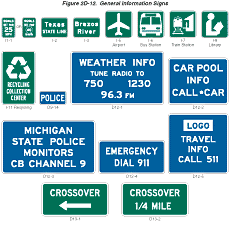
Standard:
The logo of a commercial entity shall not be incorporated within
the TRAVEL INFO CALL 511 sign.
The TRAVEL INFO CALL 511 sign shall have a white legend and border on a blue background.
Guidance:
If the logo of the transportation agency or the travel information
service or program is used, the logo's maximum height should not
exceed two times the letter height used in the legend of the sign.
Option:
The Emergency Medical Services (D9-13) symbol sign may be used to
identify medical service facilities that have been included in the
Emergency Medical Services system under a signing policy developed
by the State and/or local highway agency.
Standard:
The Emergency Medical Services symbol sign shall not be used to
identify services other than qualified hospitals, ambulance stations,
and qualified free-standing emergency medical treatment centers.
If used, the Emergency Medical Services symbol shall be supplemented
by a sign identifying the type of service provided.
Option:
The Emergency Medical Services symbol sign may be used above the
HOSPITAL (D9-13a) word message sign or H (D9-2) symbol sign or above
a sign with either the legend AMBULANCE STATION (D9-13b) or EMERGENCY
MEDICAL CARE (D9-13c). The Emergency Medical Services symbol sign
may also be used to supplement Telephone (D9-1), Channel 9 Monitored
(D12-3), or POLICE (D9-14) signs.
Standard:
The legend EMERGENCY MEDICAL CARE shall not be used for services
other than qualified free-standing emergency medical treatment centers.
Guidance:
Each State should develop guidelines for the implementation of the
Emergency Medical Services symbol sign.
The State should consider the following guidelines in the preparation of its policy:
- AMBULANCE
- 24-hour service, 7 days per week.
- Staffed by two State-certified persons trained at least to the basic level.
- Vehicular communications with a hospital emergency department.
- Operator should have successfully completed an emergency vehicle operator training course.
- HOSPITAL
- 24-hour service, 7 days per week.
- Emergency department facilities with a physician (or emergency care nurse on duty within the emergency department with a physician on call) trained in emergency medical procedures on duty.
- Licensed or approved for definitive medical care by an appropriate State authority.
- Equipped for radio voice communications with ambulances and other hospitals.
- Channel 9 Monitored
- Provided by either professional or volunteer monitors.
- Available 24 hours per day, 7 days per week.
- The service should be endorsed, sponsored, or controlled by an appropriate government authority to guarantee the level of monitoring.
Section 2D.46 Reference Location Signs (D10-1 through D10-3) and Intermediate Reference Location Signs (D10-1a through D10-3a)
Support:
There are two types of reference location signs:
- Reference Location signs (D10-1, 2, and 3) show an integer distance point along a highway; and
- Intermediate Reference Location signs (D10-1a, 2a, and 3a) also show a decimal between integer distance points along a highway.
Option:
Reference Location (D10-1 to D10-3) signs (see Figure 2D-13) may
be installed along any section of a highway route or ramp to assist
road users in estimating their progress, to provide a means for
identifying the location of emergency incidents and traffic crashes,
and to aid in highway maintenance and servicing.
To augment the reference location sign system, Intermediate Reference Location (D10-1a to D10-3a) signs (see Figure 2D-13), which show the tenth of a kilometer (mile) with a decimal point, may be installed at one tenth of a kilometer (mile) intervals, or at some other regular spacing.
Figure 2D-13 Reference Location Signs
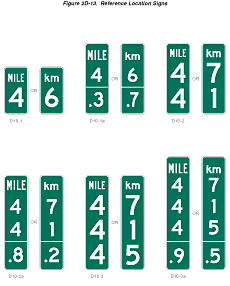
Standard:
When Intermediate Reference Location (D10-1a to D10-3a) signs are
used to augment the reference location sign system, the reference
location sign at the integer kilometer (mile) point shall display
a decimal point and a zero numeral.
When placed on freeways or expressways, Reference Location (D10-1 to D10-3) signs shall contain 250 mm (10 in) white numerals on a 300 mm (12 in) wide green background with a white border. The signs shall be 600, 900, or 1200 mm (24, 36, or 48 in) in height for one, two, or three digits, respectively, and shall contain the abbreviation km (MILE) in 100 mm (4 in) white letters.
When placed on conventional roads, Reference Location (D10-1 to D10-3) signs shall contain 150 mm (6 in) white numerals on a green background that is at least 250 mm (10 in) wide with a white border. The signs shall contain the abbreviation km (MILE) in 100 mm (4 in) white letters.
The design details for reference location signs shall be as shown in the "Standard Highway Signs" book (see Section 1A.11).
Reference location signs shall have a minimum mounting height of 1.2 m (4 ft) to the bottom of the sign in accordance with the mounting height requirements of delineators (see Section 3D.04) and shall not be governed by the mounting height requirements prescribed in Section 2A.18.
The distance numbering shall be continuous for each route within a State, except where overlaps occur (see Section 2E.28). Where routes overlap, reference location sign continuity shall be established for only one of the routes. If one of the overlapping routes is an Interstate route, that route shall be selected for continuity of distance numbering.
For divided highways, the distance measurement shall be made on the northbound and eastbound roadways. The reference location signs for southbound or westbound roadways shall be set at locations directly opposite the reference location signs for the northbound or eastbound roadways.
Guidance:
Zero distance should begin at the south and west State lines, or
at the south and west terminus points where routes begin within
a State.
On a route without reference location sign continuity, the first reference location sign beyond the overlap should indicate the total distance traveled on the route so that road users will have a means of correlating their travel distance between reference location signs with that shown on their odometer.
Standard:
Except as provided in the option below, reference location signs
shall be installed on the right side of the roadway.
Option:
Where conditions limit or restrict the use of reference location
signs on the right side of the roadway, they may be installed in
the median. On two-lane conventional roadways, reference location
signs may be installed on one side of the roadway only and may be
installed back-to-back. Reference location signs may be placed up
to 9 m (30 ft) from the edge of the pavement.
If a reference location sign cannot be installed in the correct location, it may be moved in either direction as much as 15 m (50 ft).
Guidance:
If a reference location sign cannot be placed within 15 m (50 ft)
of the correct location, it should be omitted.
Option:
Enhanced reference location signs (see Section
2E.54) may also be used on conventional roads.
Section 2D.47 Traffic Signal Speed Sign (I1-1)
Option:
The Traffic Signal Speed (I1-1) sign (see Figure 2D-12), reading
SIGNALS SET FOR XX km/h (XX MPH), may be used to indicate a section
of street or highway on which the traffic control signals are coordinated
into a progressive system timed for a specified speed at all hours
during which they are operated in a coordinated mode.
Guidance:
If used, the sign should be mounted as near as practical to each
intersection where the timed speed changes, and at intervals of
several blocks throughout any section where the timed speed remains
constant.
Standard:
The Traffic Signal Speed sign shall be a minimum of 300 x 450 mm
(12 x 18 in) with the longer dimension vertical. It shall have a
white message and border on a green background.
Section 2D.48 General Information Signs (I Series)
Support:
Of interest to the traveler, though not directly necessary for guidance,
are numerous kinds of information that can properly be conveyed
by general information signs (see Figure 2D-12). They include such
items as State lines, City limits, other political boundaries, time
zones, stream names, elevations, landmarks, and similar items of
geographical interest, and safety and transportation-related messages.
Chapter 2H contains recreational and cultural interest area symbol
signs that are sometimes used in combination with general information
signs.
Guidance:
General information signs should not be installed within a series
of guide signs or at other equally critical locations, unless there
are specific reasons for orienting the road user or identifying
control points for activities that are clearly in the public interest.
On all such signs, the designs should be simple and dignified, devoid
of any advertising, and in general conformance with other guide
signing.
Option:
An information symbol sign (I-5 through I-8, I-11) may be used to
identify a route leading to a transportation or general information
facility, or to provide additional guidance to the facility. The
symbol sign may be supplemented by an educational plaque where necessary;
also, the name of the facility may be used if needed to distinguish
between similar facilities.
Guide signs for commercial service airports and noncarrier airports may be provided from the nearest Interstate, other freeway, or conventional highway intersection directly to the airport, normally not to exceed 25 km (15 mi). The Airport (I-5) symbol sign along with a supplemental plaque may be used to indicate the specific name of the airport. An Airport symbol sign, with or without a supplemental name plaque or the word AIRPORT, and an arrow may be used as a trailblazer.
Standard:
Adequate trailblazer signs shall be in place prior to installing
the airport guide signs.
Support:
Location and placement of all airport guide signs depends upon the
availability of longitudinal spacing on highways.
Standard:
When a sign is used to display a safety or transportation-related
message, the display format shall not be of a type that would be
considered similar to advertising displays. Messages and symbols
that resemble any official traffic control device shall not be used
on safety or transportation-related message signs.
Option:
Political jurisdiction logos may be placed on the political boundary
general information signs. The logo may have different colors and
shapes but should be simple, dignified, and devoid of any advertising.
Standard:
Except for political boundary and scenic by-way logos and signs,
general information signs shall have white legends and borders on
green rectangular-shaped backgrounds.
Option:
The Recycling Collection Center (I-11) symbol sign may be used to
direct road users to recycling collection centers.
Guidance:
The Recycling Collection Center symbol sign should not be used on
freeways and expressways.
Standard:
If used on freeways or expressways, the Recycling Collection Center
symbol sign shall be considered one of the supplemental sign destinations.
Section 2D.49 Signing of Named Highways
Support:
Legislative bodies will occasionally adopt an act or resolution
memorializing a highway, bridge, or other component of the highway.
Guidance:
Such memorial names should not appear on or along a highway, or
be placed on bridges or other highway components. The requirement
for signing should be carried out by placing a memorial plaque in
a rest area, scenic overlook, recreational area, or other appropriate
location where parking is provided with the signing inconspicuously
located relative to vehicle operations along the highway.
Option:
If the installation of a memorial plaque off the main roadway is
not practical, memorial signs may be installed on the mainline.
Standard:
Where such memorial signs are installed on the mainline, (1) memorial
names shall not appear on directional guide signs, (2) memorial
signs shall not interfere with the placement of any other necessary
highway signing, and (3) memorial signs shall not compromise the
safety or efficiency of traffic flow. The memorial signing shall
be limited to one sign at an appropriate location in each route
direction.
Option:
Guide signs may contain street or highway names if the purpose is
to enhance driver communication and guidance; however, they are
to be considered as supplemental information to route numbers.
Standard:
Highway names shall not replace official numeral designations. Memorial
names shall not appear on supplemental signs or on any other information
sign either on or along the highway or its intersecting routes.
The use of route signs shall be restricted to signs officially used for guidance of traffic in accordance with this Manual and the "Purpose and Policy" statement of the American Association of State Highway and Transportation Officials that applies to Interstate and U.S. numbered routes (see Addresses for AASHTO's address).
Option:
Unnumbered routes having major importance to proper guidance of
traffic may be signed if carried out in accordance with the aforementioned
policies. For unnumbered highways, a name to enhance route guidance
may be used where the name is applied consistently throughout its
length.
Guidance:
Only one name should be used to identify any highway, whether numbered
or unnumbered.
Section 2D.50 Trail Signs
Support:
Trail signs are informational signs, plaques, or shields designed
to provide road users with route guidance in following a trail of
particular cultural, historical, or educational significance.
Guidance:
Primary guidance should be in the form of printed literature and
strip maps rather than trail signing.
Option:
Trail signs may be installed on a highway if they have been approved
by the appropriate transportation agency.
Section 2D.51 Crossover Signs (D13 Series)
Option:
Crossover signs may be installed on divided highways to identify
median openings not otherwise identified by warning or other guide
signs.
Standard:
A CROSSOVER (D13-1) sign (see Figure 2D-12)
shall not be used to identify a median opening that is permitted
to be used only by official or authorized vehicles. If used, the
sign shall be a horizontal rectangle of appropriate size to carry
the word CROSSOVER and a horizontal directional arrow. The CROSSOVER
sign shall have a white legend and border on a green background.
Guidance:
If used, the CROSSOVER sign should be installed immediately beyond
the median opening, either on the right side of the roadway or in
the median.
Option:
The Advance Crossover (D13-2) sign (see Figure 2D-12) may be installed
in advance of the CROSSOVER sign to provide advance notice of the
crossover.
Standard:
If used, the Advance Crossover sign shall be a horizontal rectangle
of appropriate size to carry the word CROSSOVER and the distance
to the median opening. The sign shall have white legend and border
on a green background.
Guidance:
The distance shown on the Advance Crossover sign should be 2 km,
1 km, or 500 m or should be 1 MILE, 1/2, or 1/4 MILE, unless unusual
conditions require some other distance. If used, the sign should
be installed either on the right side of the roadway or in the median
at approximately the distance shown.
Section 2D.52 National Scenic Byways Signs (D6-4, D6-4a)
Support:
Certain roads have been designated by the U.S. Secretary of Transportation
as National Scenic Byways or All-American Roads based on their archeological,
cultural, historic, natural, recreational, or scenic qualities.
Option:
State and local highway agencies may install the National Scenic
Byways (D6-4 or D6-4a) signs at entrance points to a route that
has been recognized by the U.S. Secretary of Transportation as a
National Scenic Byway or an All-American road. The D6-4 or D6-4a
sign may be installed on route sign assemblies (see Figure 2D-14)
or as part of larger roadside structures. National Scenic Byways
Signs may also be installed at periodic intervals along the designated
route and at intersections where the designated route turns or follows
a different numbered highway. At locations where roadside features
have been developed to enhance the traveler's experience such as
rest areas, historic sites, interpretive facilities, or scenic overlooks,
the National Scenic Byways Sign may be placed on the associated
sign assembly to inform travelers that the site contributes to the
byway travel experience.
Figure 2D-14 Examples of Use of the National Scenic Byways Sign

Standard:
When a National Scenic Byways Sign is installed on a National Scenic
Byway or an All-American Road, the design shown for the D6-4 or
D6-4a sign in Figure 2D-14 shall be used. Use of this design shall
be limited to routes that have been designated as a National Scenic
Byway or All-American Roads by the U.S. Secretary of Transportation.
If used, the D6-4 or D6-4a sign shall be placed such that the roadway route signs have primary visibility for the road user.
